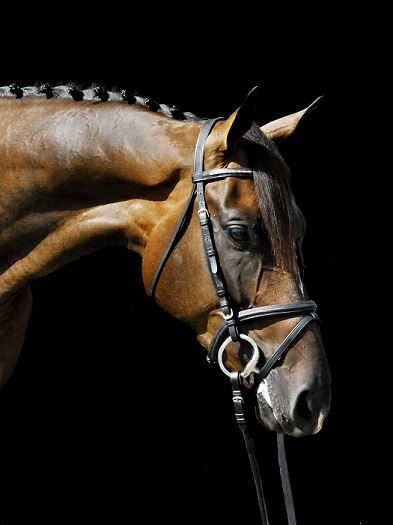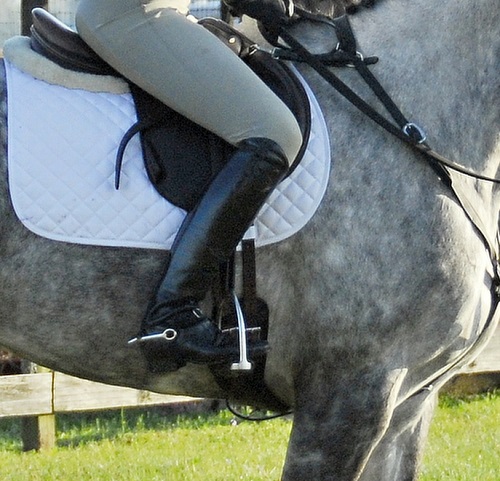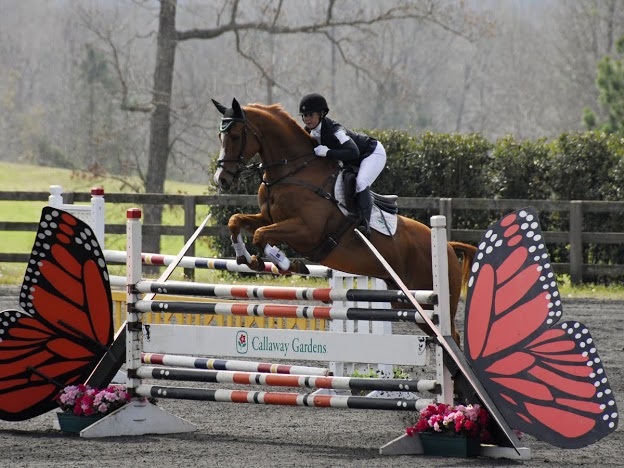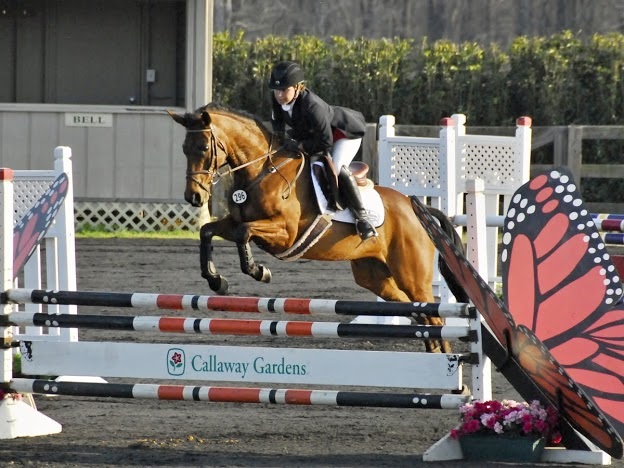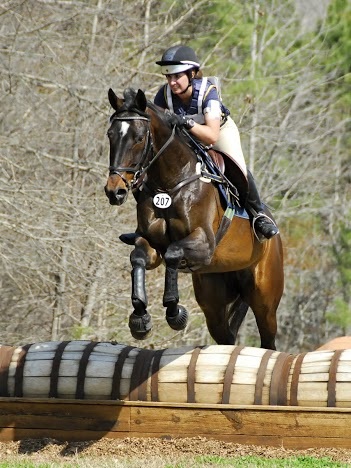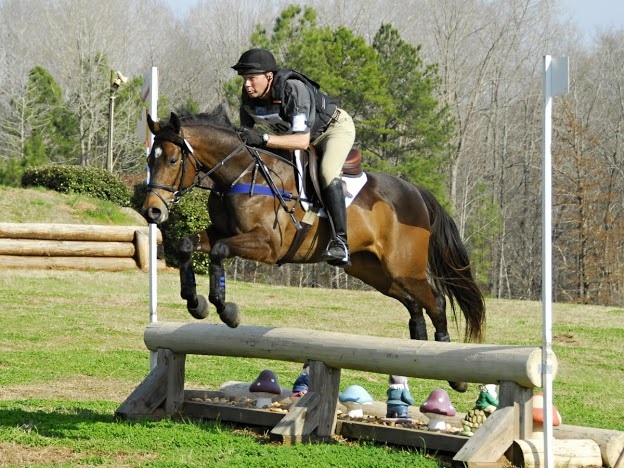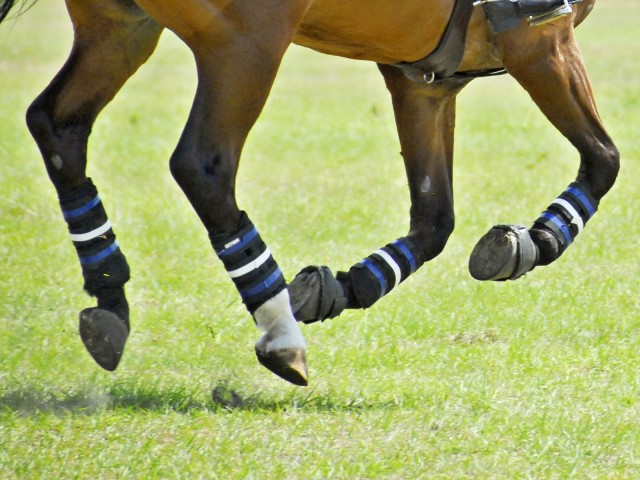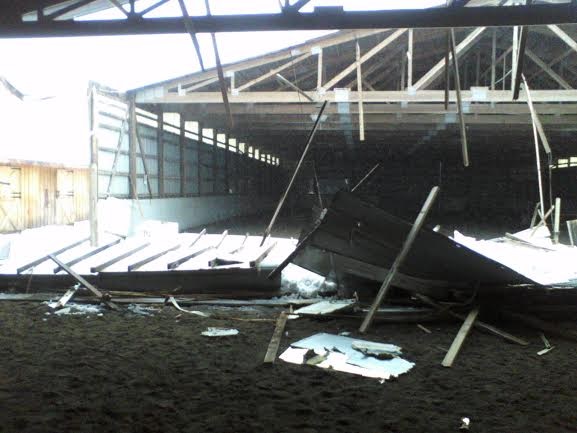 The feeling as you cross through the finish flags makes it all worthwhile. Photo by Ivegotyourpicture.com.
The feeling as you cross through the finish flags makes it all worthwhile. Photo by Ivegotyourpicture.com.
You may have read my post yesterday, 5 Things I Learned Riding Three Horses at a One-Day Event. I took three horses: a four-year-old filly doing her first event at Entry level; a five-year-old (Aero) doing his first event, at BN; and a six-year-old with several training level events under his belt. I definitely confirmed one thing: I am NOT Buck Davidson! I’m glad I survived, I’m glad my horses gained experience and confidence, but I don’t think I’ll ever try that many rides in a day again.
Ride times:
- Entry level– 8:14, 9:00, 10:36.
- Beginner novice– 9:32, 10:10, 11:30.
- Training level — 10:55, 1:12, 2:25.
Here was my schedule for Saturday:
4:30am: Feed horses. Quickly go over them in the barn lights and clean up any stains; Showsheen and brush tails, touch up braids if needed.
5:25am: Put shipping boots on. Watch the “experienced” training level horse run around like an idiot in his stall, excited to go on a car ride.
5:30am: Load and leave.
6:15am: Arrive at show grounds, in the dark. Lunge the Aero the toddler in the moonlight to settle him a bit, knowing he won’t have enough warm up time later for dressage. He was fresh and a little distracted, but reasonably obedient.
7:00am: It’s almost daylight. Get packets. Clean up the baby four-year-old gray filly. Give her a light spin on the lunge line, instead of letting her “lunge” herself tied to the trailer.
7:25am: Get on the baby gray filly for dressage. Jig sideways to warmup area. Trot around warmup at breakneck speed, head held higher than a giraffe. Canter; get both leads (success!) and try to remind her how to steer. Try not to kill kids on ponies concentrating obliviously on 20m circles. Avoid obvious stares of “Why is she here on that crazy thing?”
8:12am: Filly finally settles a little bit. Almost trotting with some sense of two-beat rhythm, and I can see over her ears now. Ring 2 is running early; may as well go ahead and get it over with, another two minutes of warmup isn’t going to fix anything. Go into the main arena and the filly is completely overwhelmed. Ears in my face, body wiggling sideways, incapable of moving in a straight line or performing a transition anywhere near a letter. At least she sort of maintained the intended gait, and more or less completed the pattern in the proper order. Geometry be damned. The judge was incredibly nice, smiling and laughing, and congratulated me for staying on. Well, there’s that.
8:25am: Tack for show jumping. Go ahead and put cross-country boots on now, there won’t be much time to change into them later.
8:35am: Get on baby gray filly for show jumping. She’s slightly more settled now and our steering has returned. Hopped over a few warmup fences like no big deal, stood quietly to watch kids on ponies wobble around the 18″ jumper class.
9:05am: Jumper ring is running a bit late, the gray filly was the first one to go in the two-foot class (Entry three-phase division). We trotted the first fence, awkwardly wiggled over the second, and then she locked into a beautiful canter rhythm and loped her way around the rest of the course quite happily. For her first ever show jump course, I was very proud. Good girl!

The four-year-old gray filly did well in her first show jumping course. Photo by Ivegotyourpicture.com.
9:08am: Hurry back to the trailer, untack as fast as possible. Unload Aero and tack him for dressage ASAP.
9:15am: Get on Aero and head to dressage warm up. He felt fairly calm and confident until he saw 25 horses and ponies milling around in a confined space. While he’s been on field trips off the farm before, it’s only been with one or two other horses. A show environment was entirely new and he was completely unwound. All his progress at home was for naught.
9:32am: Time for Aero’s dressage test. Same arena, same judge. Different horse looking wild and insubordinate. Wow, I feel like a crappy rider. Not much I can do except patiently struggle through it, trying to rub his neck and reassure him, bitterly thinking this horse is capable of scoring in the low 30s on a good day and here he is acting like a jackass. Today is not a good day. He ended the test with a crooked halt (but immobile, at least). The judge again smiled knowingly and praised me for my patience with him. I thanked her for her time and apologized for the pitiful display of incompetence. I couldn’t forget that test (or the first one) quickly enough.
9:40am: Swap Aero’s dressage tack for jumping tack. Despite his anxiety attack in dressage, he was very mellow and well-behaved at the trailer all day long. Plus one for moral victories?
9:50am: Get on Aero to warm up for show jumping. Unfortunately, show jumping warm-up was in a very small, crowded space, making for tight slick turns. Aero continued to feel a bit claustrophobic. He had moments where he would try to relax, but it was difficult. I kept thinking “soft hands, leg on” but it’s not easy when you feel like you’re on a time bomb. Green horses can be so unpredictable; at home they’re quiet and confident, at a show they can turn into a frantic puddle of jell-o. All you can do is take a deep breath, roll your eyes, and know it will get better eventually.
10:15am: Aero was supposed to jump a few minutes ago, but the show jumping ring is just a bit behind. The longer warmup time did not help, he was just more wound up. When he got into the ring, he spooked at four-wheelers on the nearby cross-country course. Then he shied at photographers. The judges stand in the corner sent him skittering sideways. Thankfully, he wasn’t concerned about the jumps whatsoever– that was the easy part. Poor immature horse just overwhelmed by the environment. He should get better as he gets out more. I made a mental note, though, not to be early to cross-country warmup!

Aero overcame his anxiety enough to jump a clear round for his first time at a show. Photo by Ivegotyourpicture.com.
10:20am: Yank the jump saddle and breastplate off of Aero and throw it on the gray filly for cross-country. Also, tack up the training level horse for dressage and load him back on the trailer for later.
10:25am: Warm up the gray filly for cross-country. She’s quiet, settled, relaxed and responsive. She’s got this showing thing all figured out now. We popped over the little logs in warmup and she was good to go.
10:40am: Cross-country is running behind. We were supposed to go a few minutes earlier. I asked the xc starters to radio the dressage stewards and tell them I’d be late on my training horse.
10:41am: “5, 4, 3, 2, 1, Have a Good Ride!” The gray filly trotted out of the start box and boldy over the first tiny two-foot fence. We loped around the whole course in a fantastic rhythm, like a hunter derby. She hesitated slightly at the water, but trotted on through and jumped the entire course with ease and confidence. I smiled the whole way and was basically a passenger needing only to steer toward the next set of flags. Baby’s first cross-country was a huge success. What an awesome girl!

Finishing the entry level cross-country course. She’s officially an event horse now! Photo by Ivegotyourpicture.com.
10:50am: Hurry back to the trailer, swap bridle from gray filly to training level horse, get on him and trot to dressage warm-up. Thankfully my friend was a huge help and cooled out the filly for me.
10:55am: Dressage stewards tell me they thought I had scratched since I hadn’t showed up…I tried to explain the conflict with cross-country and show jumping running late (apparently the xc starters hadn’t radioed them). My dressage time was 10:55, and I was to get in Ring 1 immediately, no ifs ands or buts. I managed to canter one circle in warmup and then went directly to the ring.
10:56am: My poor training level horse usually needs a good long warmup, with at least 15 minutes of patient walking lateral work to settle into a soft, relaxed, obedient mindset. He got none of that. Considering he went right from the trailer to the ring, he did his best. He had some nice moments, but also some resistance and tension (that probably would have been greatly helped with adequate warmup time). It was far from his best test, but it wasn’t a disaster; I can’t blame the mistakes on him, as it was largely due to my mad rush with multiple horses.
11:03am: Untack the training level horse, give him a peppermint, and take a deep breath. I actually had a moment to sit down, drink a bottle of water, and think about my upcoming beginner novice course.
11:45am: Unload Aero and tack him for cross-country. Dawdle around and waste time…normally I get on about 25 minutes before my ride time, but I didn’t want Aero to be stressed in warmup a minute more than necessary. It’s hard making yourself be “late” on purpose.
12:05pm: Get on Aero and head to cross-country warmup. He was still a bit on the muscle, but the ticking time-bomb feeling was gone. We jumped a few warm up fences and tried to keep moving until it was our time.
12:15pm: Another “Have a good ride!” and we leave the box. He trotted nicely over the first fence and landed eagerly with a bouncy, forward canter. Approaching the second, he took one look at it surrounded by other levels’ jumps and (gasp!) jump judges, and he propped/spun sideways. I don’t think he even saw the jump in front of him, his eyeballs were completely going east-west. I stuffed him over the fence awkwardly, I’m not sure if they counted it as a stop or not. I let him trot the next several fences, so he had time to process all the extraneous stuff and focus on his intended target. By about fence 7, he was getting the hang of it and I let him canter. He jumped bravely over the beginner novice “coffin,” and went into the water with just a bit of suspicion. We trotted the last few jumps and he walked back to the trailer feeling pretty proud of himself. I was humbly reminded that most green horses are not as easy as the gray filly!

Aero gallops around his first full cross-country course at Beginner Novice. Photo by Ivegotyourpicture.com.
12:20pm: Untack and cool out Aero.
12:30pm: Swap bits on the bridle and tack up the training level horse for show jumping.
12:50pm: Get on the training level horse and head to show jumping warmup. Show jumping is again running behind, but not sure how much. I jump a warm-up fence and realize that a waterford, his normal show jumping bit, was not going to work today. I debated going back to the trailer to change it, but didn’t know when my turn would come. I decided to tough it out.
1:20pm: Suffer through the training level show jump course. Big mistake to stay in the waterford. Show jumping in the large open field, right next to cross-country, had my horse thinking other ideas about control. He ran past several distances and I struggled to hold him together. We had a disappointing two rails down (the first rails he’s ever had) and I rode like crap while he pulled my arms out. I was feeling pretty tired by this point; three hours of sleep, waking up at 4am, and seven previous rides was taking its toll.

The last fence on the training level show jump course. Photo by Ivegotyourpicture.com.
1:25pm: Strip off the show jumping tack, sit down and try to recover before cross-country. Pray that the new cross-country bit will help; decide that if he feels too strong at any point, I will pull up and retire.
1:45pm: Tack the training level horse for cross-country. I was trying a three-ring gag on him for the first time in competition, and I had planned to use the second ring just below the snaffle. After the show jumping debacle, I moved it to the third ring for extra leverage. (I also ride with a snaffle rein.)
2:05pm: Get on for the last time, to warm up for training level cross-country. Test out the new brakes: working great. I used to ride him in a pelham, but he started backing off it too much, curling and diving on his forehand. I tried a variety of snaffles, twisted, Myler, but none were quite right. The three-ring gave me enough leverage for control, but he’d still take contact and keep his balance up.
2:25pm: For the last time, “three, two, one, have a nice ride!” We started off immediately into a great rhythm, and kept it the whole way around. I was able to half-halt effectively for each fence, and my horse felt super. It was the best round he’d done; he never lacks for confidence or boldness, but his enthusiasm can make him a tough ride. Today was a walk in the park. I still felt like I was on a high-powered rocket, but I had full control of the throttle. We had an odd distance or two near the end– I think my eye was worn out!– but he jumped safely and comfortably and we both had a great time.

Had a fun time on the training level cross-country.
2:32pm: Cool him out, take his braids out, try to sort through the mess of tack and sweaty saddle pads thrown all over the bed of the truck.
2:45pm: Load up and head home. Thank husband and friend profusely for their help, feel satisfied that all horses finished the day on a positive note. Reflect on how nice the gray filly is and will be, how much farther Aero has to go, and be thankful that the last horse took care of me when I needed it (for once). Proclaim that professional riders like Buck Davidson are super human and vow never attempt to show three horses in three phases in one day ever again!






